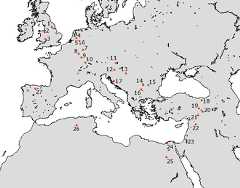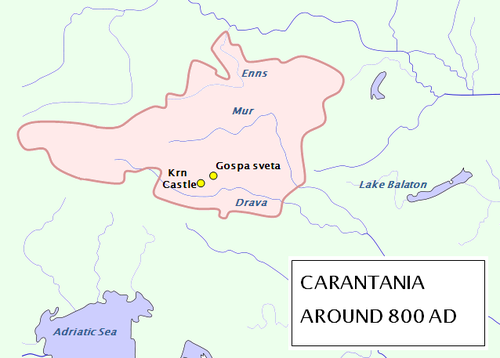 | Wikimedia Commons Atlas of the World TheWikimedia Atlas of the World is an organized and commented collection of geographical, political and historical maps available atWikimedia Commons. Discussion •Update the atlas •Index of the Atlas •Atlas in categories •Other atlases on line |  |
|
| ||||||||||||||||||||||||||||||||||||||||
 | Karte von Österreich Map of Austria |
 | Karte von Österreich Map of Austria (in German) |
 | Karte von Österreich Map of Austria |
 | Karte von Österreich Map of Austria |
 | Topographische Karte von Österreich Topographic map of Austria |
 | Geographische Karte von Österreich reliefmap of Austria |
This section holds maps of the administrative divisions.
This section holds a short summary of the history of the area of present-day Austria, illustrated with maps, including historical maps of former countries and empires that included present-day Austria.
 | Possible extent of (proto-)Celtic influence 800-400 BC Die Kelten in Europa. Ocker: Kernbereich Nordwestalpine Hallstattkultur (ca. 750–500/450 v. Chr.) grün: Ausbreitung La-Tène-Kultur, bzw. orange: der keltischen Sprache (3. Jh. v. Chr.) |
 | Celts in Europe Die Kelten in Europa |
 | Territorial development of theRoman Empire 264 BC-192, Territoriale Entwicklung des Römischen Reiches, inklusive die Eroberung des hießigen Österreichs |
 | Map of theRoman Empire, 50 BC Das Römische Reich im Jahre 50 v. Chr. |
 | The extent of theRoman Republic andRoman Empire; Die territoriale Entwicklung der Römische Republik und des Römischen Reiches. ) |
 | Camps of the Roman Legions, AD 80 Römische Legionen im Jahre 80 |
 | Map of theRoman Empire, AD 116 Das Römische Reich im Jahre 116 |
 | The Roman Empire and Germania, AD 116 Das Römische Reich und Germanien im Jahre 116 |
 | Raetia in the Roman Empire, AD 116 Raetia im Römischen Reich (116) |
 | Roman Empire, AD 117 Das Römische Reich im Jahre 117 |
 | Roman Empire, AD 117 Das Römische Reich im Jahre 117 |
 | The Roman Provinces in present-day Austria |
 | Rhaetian and Upper Germanic Limes Rhätien und Obergermanien mit Limes |
 | Roman Empire divided 395, showing the dioceses and praetorian prefectures ofGaul,Italy,Illyricum and Oriens (east), roughly analogous to the fourTetrarch zones of influence afterDiocletian's reforms. Die Teilung des Römischen Reiches |
 | Western Roman Empire 395 Das Weströmische Reich im jahre 395 |
 | The division of the Empire after the death ofTheodosius I, ca. 395 AD superimposed on modern borders.Die Teilung des Römischen Reiches rund dem jahre 395. |
 | Invasions of theRoman Empire 100-500 |
 | Invasions of the Roman Empire 100-500 |
 | Division of the Roman Empire in 406 |
 | Eastern Roman Empire andWestern Roman Empire, ca. 476 |
 | Map ofKarantania |
 | Rise of theFrankish Empire |
 | Carolingian Empire around 800 |
 | The Franconian Empire |
 | Carolingian Empire (in French) |
 | Europe in 814 Europa im Jahre 814 |
 | Treaty of Verdun (843) andTreaty of Meerssen (870) |
 | Division of the Frankish Empire after 870 |
 | Central Europe 919-1125 |
 | The Duchy ofBavaria in the 10th century |
| border|251x400px | Holy Roman Empire, 10th century |
 | The area ruled by Ottokar II, between 1253 and 1271 |
 | The Holy Roman Empire in the 14th century |
 | The Holy Roman Empire and its circles in 1512 |
 | The same map in German. |
 | The (Habsburg) Empire of Charles I/V. |
 | The (Habsburg) Empire of Charles I/V |
 | Religious situation in central Europe about 1618 |
 | Area controlled by the Holy Roman Empire around 1630 |
 | German Confederation |
 | Borders of the German Confederation in 1820 |
 | Alliances of the member-states of the formerGerman Confederation in theAustro-Prussian War, 1866 |
 | Aftermath of the Austro-Prussian War (1866). |
 | In 1867 theAustrian Empire was continued byAustria-Hungary, making both Austria andHungary constituent monarchies. |
 | French map of Austria-Hungary 1887. Pink : Cisleithania. Yellow : Transleithania. Orange : Ottoman Bosnia under austrian-hungarian occupation |
 | Kingdoms and countries of Austria–Hungary: Cisleithania: 1.Bohemia, 2.Bukovina, 3.Carinthia, 4.Carniola, 5.Dalmatia, 6.Galicia, 7.Austrian Littoral, 8.Lower Austria, 9.Moravia, 10.Salzburg, 11.Silesia, 12.Styria, 13.Tyrol, 14.Upper Austria, 15.Vorarlberg; |
 | Religions in Austria-Hungary, Andrees Allgemeiner Handatlas, 1st Edition, Leipzig (Germany) 1881 |
 | Ethnic map of Austria-Hungary, census 1880. German version |
 | Ethnic map of Austria-Hungary, census 1890. English version |
 | Historical map of Austria-Hungary from theBibliothek allgemeinen und praktischen Wissens für Militäranwärter Band I, 1905 |
 |
 | ProposedUnited States of Greater Austria |
 | The end ofAustria-Hungary (in German) |
 | Austria became an independent country after the dissolution of Austria-Hungary. This map shows the claims of German-Austria in 1918. The red lines are the real borders realized and presently. |
 | The same map in English |
 | Austria as part of Germany on August 31, 1939 |
 | idem |
 | Administrative districts in territories under the control of Nazi Germany in 1941. Großdeutschland im Jahre 1941 |
 | Eastern front of the Second World War circa 1941-1942. |
 | Austria under allied occupation |
This section holds copies of original general maps more than 70 years old.
 | Extreme points |
 | Comparison of Area with a circle |
 | Breweries in Austria |
 | German dialects |
 | Church provinces |
 | Election toNationalrat 2006 |
 | Traffical Regions (Verkehrsverbünde) |
 | Justizanstalten |
 | Satellite map |
 | Satellite map |
 | Satellite map |
 | Satellitemap of Austria |
 | Satellitemap of Austria Landsat with boundaries of the "Bundesländer" |
 | Satellitemap with boundaries of the "Bundesländer" |
 | Satellitemap with boundaries of the "Grosslandschaften" |
General remarks:
|